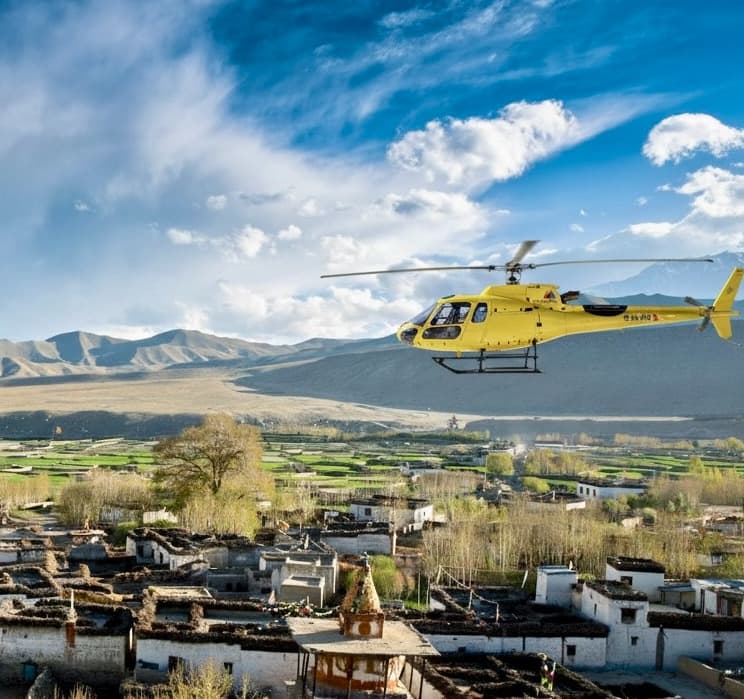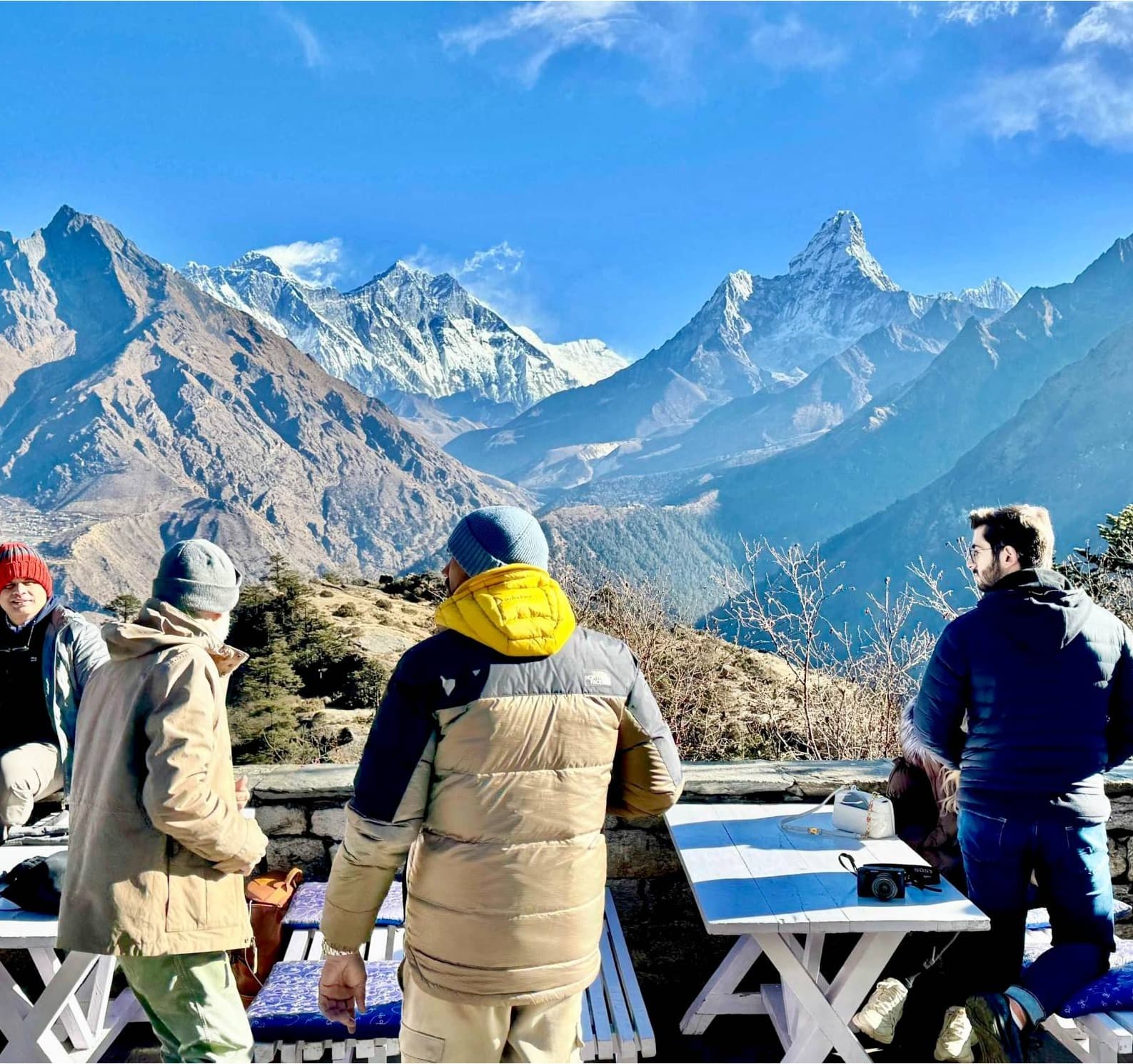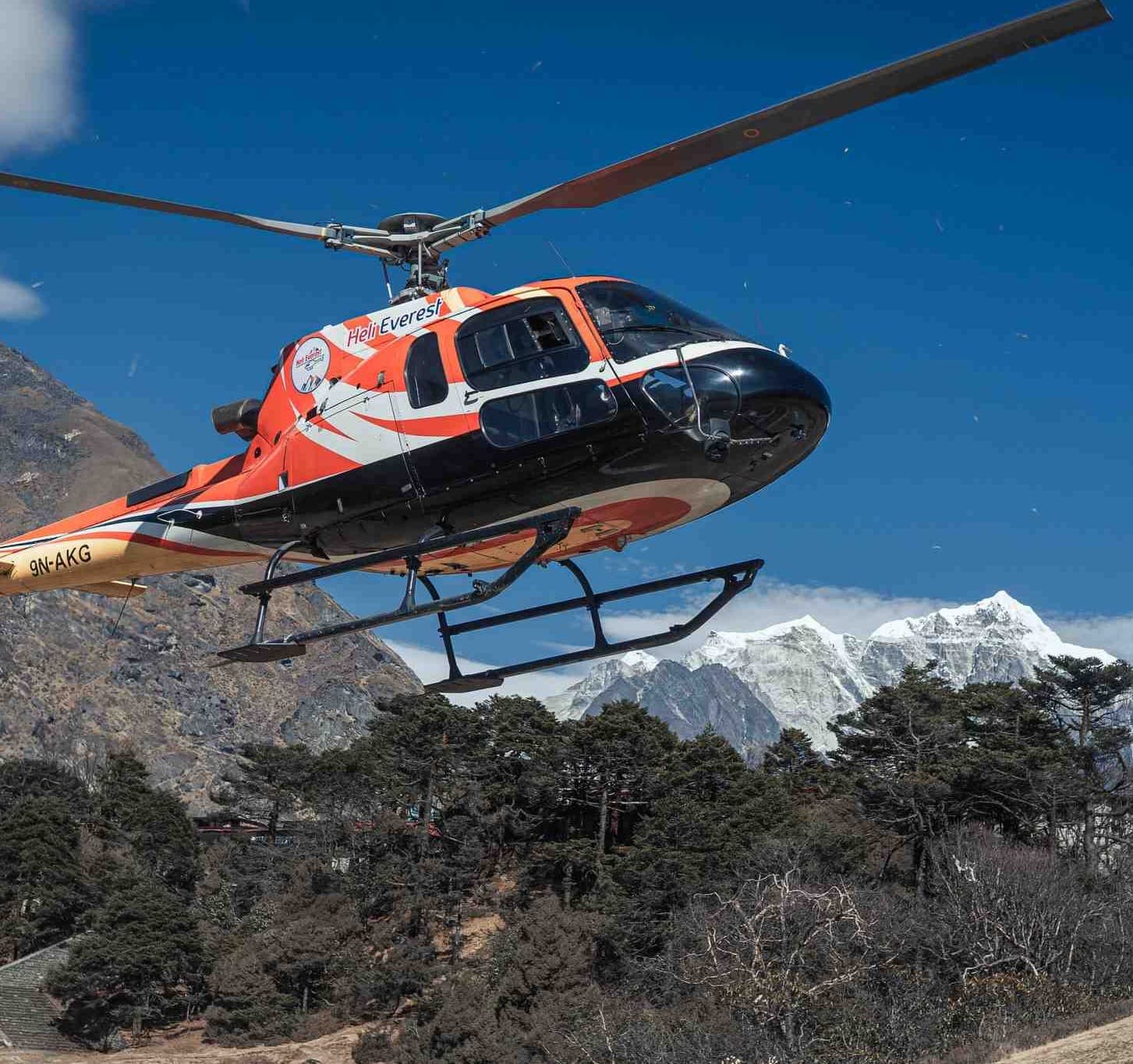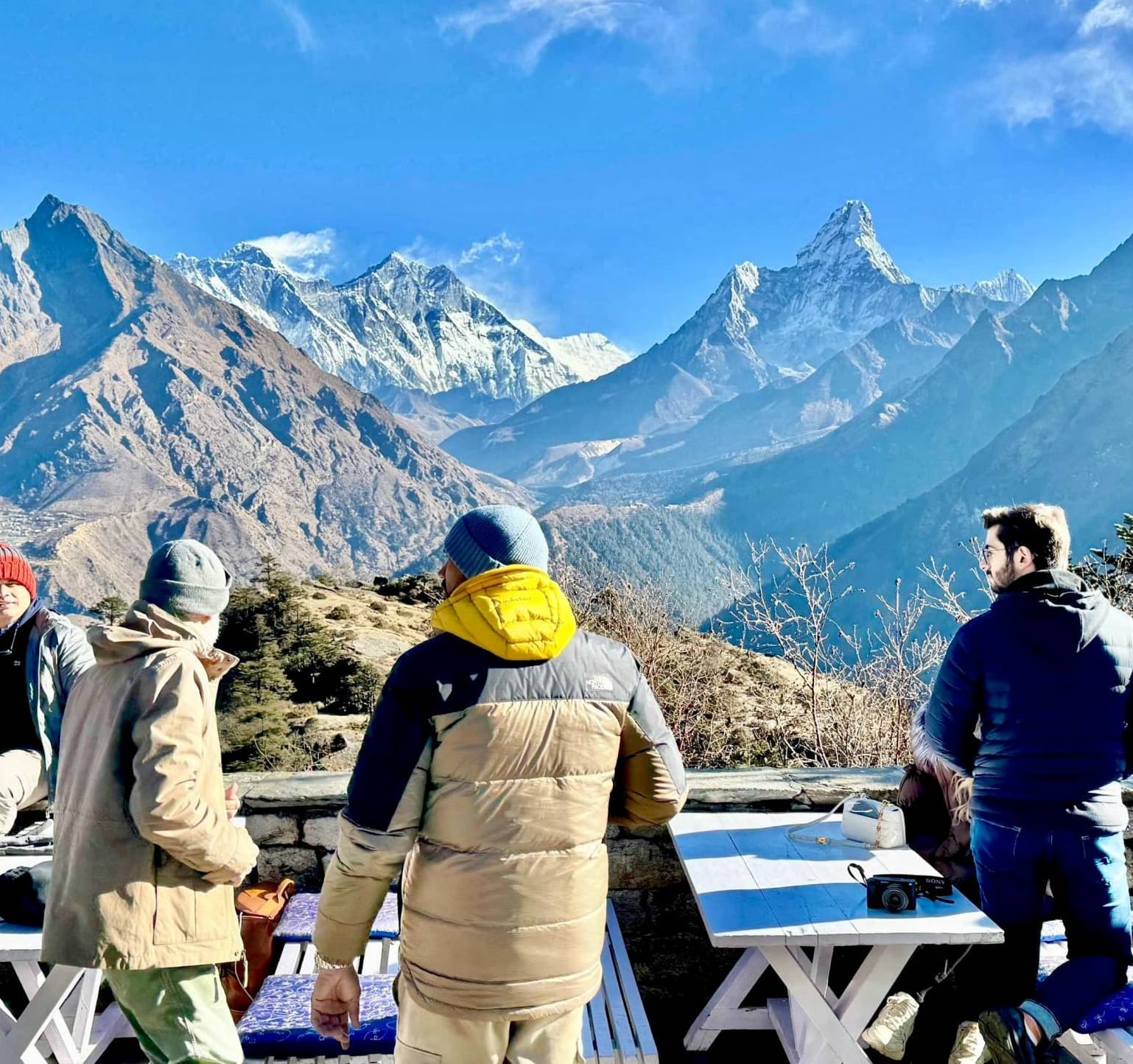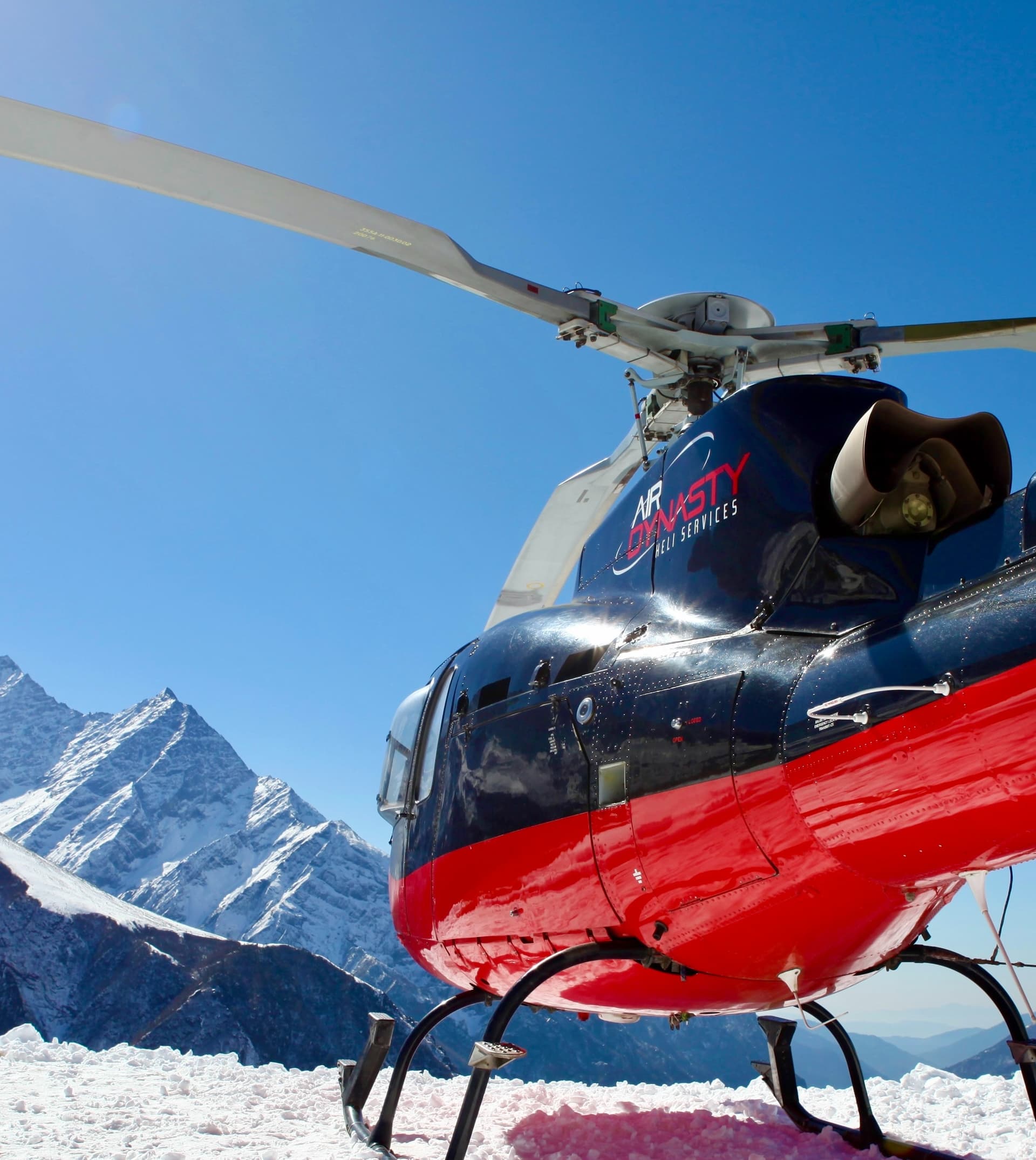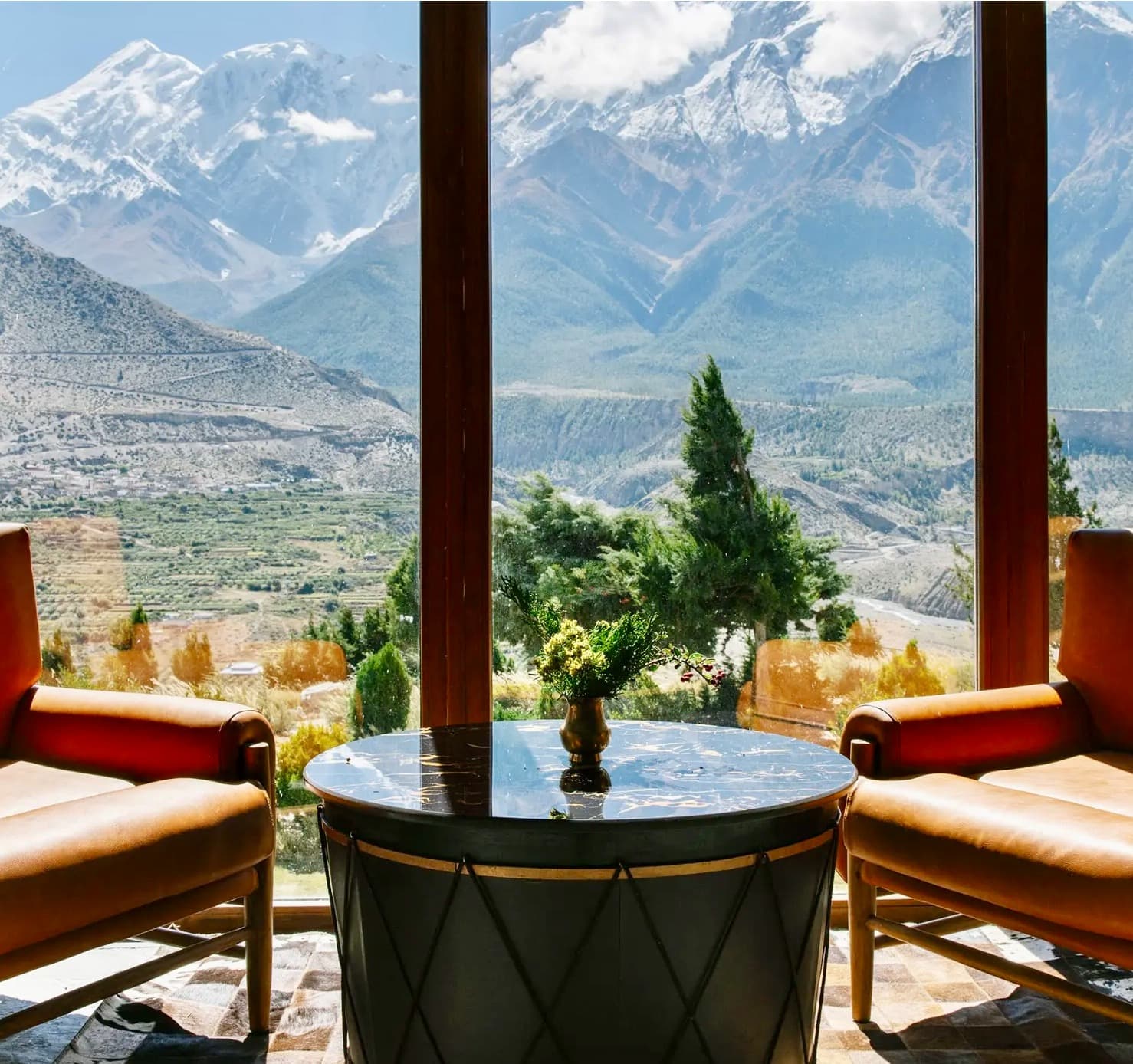Luxury trekking in Nepal offers a refined way to explore the Himalayas without giving up comfort or authenticity. With Luxury Holidays Nepal, you trek through iconic mountain landscapes while enjoying premium lodges, experienced guides, personalized service, and carefully planned itineraries. Each journey is designed to balance scenic walking days, proper acclimatization, and high-quality accommodations, ensuring a safe and comfortable trekking experience. From Everest and Annapurna to Upper Mustang and Langtang, our luxury trekking packages combine adventure, culture, and comfort for travelers who want to experience Nepal’s mountains at their best.
Why Choose Luxury Trekking in Nepal
Luxury trekking in Nepal is ideal for travelers who want to experience the Himalayas without the usual discomforts of high-altitude trekking. It keeps the adventure authentic while adding comfort, safety, and thoughtful planning.
Comfort without losing the trekking spirit: You walk the same legendary trails as classic trekkers, but stay in the best available lodges or boutique mountain hotels with private rooms, warm bedding, and better facilities. After a full day on the trail, proper rest makes a real difference.
Experienced guides and personal support: Luxury trekking comes with highly experienced, English-speaking guides who focus on your safety, pace, and overall experience. Smaller groups or private departures mean more attention, flexibility, and care throughout the trek.
Well-planned itineraries and acclimatization: Routes are designed with proper acclimatization days, realistic walking hours, and comfortable rest points. This reduces fatigue and altitude risks while making the journey more enjoyable.
Quality meals and hygiene standards: Nutritious, freshly prepared meals are prioritized, even in remote areas. Better food choices and hygiene standards help you stay healthy and energized on the trail.
Flexible logistics and upgrade options: Private transfers, porter support, and optional helicopter flights for returns or specific sections add convenience and save time. These options are especially valuable for travelers with limited schedules or those wanting extra comfort.
A smoother, stress-free experience: All permits, logistics, accommodation, and contingency planning are handled in advance. You can focus on the mountains, culture, and walking experience instead of operational concerns.
Luxury trekking in Nepal is not about rushing or overindulgence. It’s about traveling smarter—enjoying the Himalayas in a way that feels comfortable, safe, and deeply rewarding.
Top Luxury Trekking Routes in Nepal
Nepal offers some of the world’s finest trekking routes, and many of them can be experienced in comfort with well-selected lodges, professional support, and flexible itineraries. Below are the most popular routes for luxury trekking, chosen for their scenery, accessibility, and quality of accommodation.
Luxury Everest Base Camp Trek: This is the most iconic luxury trek in Nepal. You walk through Sherpa villages, ancient monasteries, and dramatic valleys with close-up views of Everest, Lhotse, and Ama Dablam. Premium mountain lodges, proper acclimatization days, and optional helicopter returns make this trek both comfortable and efficient.
Luxury Annapurna Circuit Trek: Known for its diversity, the Annapurna Circuit takes you from lush forests and rivers to high alpine landscapes and mountain deserts. Luxury versions focus on the best lodge stays available, private transport on road sections, and a well-paced crossing of Thorong La Pass for a safer and more enjoyable experience.
Upper Mustang Luxury Trek: Often called the “Last Forbidden Kingdom,” Upper Mustang offers a unique blend of dramatic desert scenery and Tibetan-influenced culture. Luxury trekking here includes boutique hotels in Lo Manthang, private jeeps or helicopter access for remote sections, and carefully planned walking days to reduce physical strain.
Ghorepani Poon Hill Luxury Trek: Perfect for travelers with limited time, this short luxury trek delivers stunning sunrise views over the Annapurna and Dhaulagiri ranges. Comfortable lodges, gentle walking days, and easy access from Pokhara make it ideal for families, senior travelers, and first-time trekkers.
Gokyo Lakes & Everest View Luxury Trek: This route offers a quieter alternative to the main Everest trail, featuring turquoise glacial lakes and panoramic viewpoints. Luxury lodges, extra acclimatization days, and helicopter options allow you to enjoy high-altitude scenery without long, demanding descents.
Each of these routes can be customized based on walking pace, accommodation preference, and travel time. Luxury trekking is not about changing the destination—it’s about improving how you experience it.
Best Time to Go for Luxury Trekking in Nepal
Choosing the right season is key to enjoying a comfortable and rewarding luxury trekking experience in Nepal. Weather, visibility, and trail conditions all play an important role, especially when comfort and safety are priorities.
Spring (March to May)
Spring is one of the best seasons for luxury trekking. Days are generally warm, skies are clear, and the hills come alive with blooming rhododendrons and wildflowers. Mountain views are excellent, and temperatures at higher altitudes are manageable. This season is ideal for Everest, Annapurna, Langtang, and Upper Mustang luxury treks.
Autumn (September to November)
Autumn is considered the peak trekking season in Nepal. The monsoon rains clear the atmosphere, resulting in crisp air and outstanding mountain visibility. Weather conditions are stable, trails are dry, and lodges operate at their best. Luxury trekking in autumn offers the most reliable conditions, especially for high-altitude routes like Everest Base Camp and the Annapurna Circuit.
Winter (December to February)
Winter trekking is possible for lower-altitude luxury routes such as Ghorepani Poon Hill or Everest View treks. Days are clear and uncrowded, but nights can be cold, especially above 3,000 meters. With proper planning, quality accommodation, and shorter walking days, winter can be a quiet and comfortable option for certain luxury treks.
Monsoon / Summer (June to August)
This season is less popular due to rain, clouds, and slippery trails in many regions. However, areas like Upper Mustang and parts of Dolpo lie in the rain-shadow and remain suitable for luxury trekking. Fewer crowds and lush landscapes make it an appealing option for travelers seeking something different.
For the best balance of weather, scenery, and comfort, spring and autumn remain the top choices for luxury trekking in Nepal. That said, with careful route selection and proper logistics, luxury trekking can be enjoyed almost year-round.
Prepare for Your Luxury Trekking in Nepal
Even with premium services and comfortable lodges, trekking in the Himalayas requires thoughtful preparation. A little planning goes a long way in making your luxury trekking experience smooth, safe, and enjoyable.
Physical readiness
Luxury trekking does not mean extreme difficulty, but it still involves walking several hours a day at varying altitudes. Light cardio exercise, regular walking, and short hikes before your trip will help you feel more confident and relaxed on the trail.
Packing smart, not heavy
You don’t need to overpack. Focus on quality essentials—comfortable trekking shoes, layered clothing, a warm jacket, sun protection, and personal toiletries. Luxury treks usually include porter support, but keeping your daypack light improves comfort while walking.
Altitude awareness
Proper acclimatization is built into luxury trekking itineraries, but understanding how altitude affects your body is important. Staying hydrated, walking at a steady pace, and listening to your guide are key to a safe experience.
Travel documents and insurance
Ensure your passport, visa, and travel insurance are in order before arrival. Your insurance should cover high-altitude trekking and emergency evacuation, including helicopter rescue if needed.
Health and personal items
Bring any personal medications, basic first-aid items, and travel-friendly hygiene products. While luxury lodges offer better facilities, remote areas still have limited supplies.
Mental preparation
Luxury trekking is about enjoying the journey, not rushing to the destination. Weather changes, trail conditions, and mountain life require flexibility. An open mindset helps you appreciate the experience fully.
With the right preparation, luxury trekking in Nepal becomes a rewarding blend of adventure, comfort, and natural beauty—allowing you to focus on the mountains while we take care of the rest.
Why Choose Luxury Holidays Nepal?
Choosing the right operator matters just as much as choosing the right trekking route. At Luxury Holidays Nepal, luxury trekking is built on experience, reliability, and a deep understanding of what travelers truly need in the Himalayas.
Proven expertise in luxury travel
We specialize in luxury tours, treks, and helicopter journeys across Nepal. Our team has years of hands-on experience designing high-end trekking experiences that balance comfort, safety, and authentic mountain travel.
Carefully selected accommodations
We use the best available lodges and hotels along each route—places known for cleanliness, comfort, location, and service. Where possible, we include premium mountain lodges and boutique stays to ensure proper rest after each trekking day.
Highly experienced guides and support team
Our trekking guides are professional, licensed, and deeply familiar with high-altitude environments. They focus not only on guiding but also on acclimatization, pacing, and personal care, ensuring a safe and enjoyable journey.
Personalized and flexible itineraries
No two travelers are the same. We tailor trekking plans based on your walking pace, comfort expectations, available time, and interests. Private treks, small groups, and custom upgrades are always available.
Strong logistics and safety standards
From permits and transport to backup plans and emergency support, every detail is handled in advance. We maintain clear communication, reliable equipment, and access to helicopter evacuation when required.
Transparent pricing and honest service
What we include is clearly stated, with no hidden costs. Our focus is long-term trust, not short-term sales. Many of our guests travel with us repeatedly or recommend us to friends and family.
Luxury Holidays Nepal is not about making trekking complicated or excessive. It’s about doing things properly—so your Himalayan journey feels comfortable, safe, and genuinely memorable from start to finish.
What to Pack for a Luxury Trek in Nepal
Luxury trekking allows you to travel lighter and smarter, but proper packing is still essential for comfort and safety in the mountains. The key is quality over quantity.
Clothing (layering is essential)
Pack breathable base layers, a warm insulating layer, and a good waterproof jacket. Temperatures can change quickly, especially at higher altitudes. Comfortable trekking pants, a few moisture-wicking tops, and warm sleepwear for cold nights are important.
Footwear
Well-broken-in trekking boots are a must. Add a pair of lightweight shoes or sandals for evenings at lodges. Good socks—preferably wool or trekking-specific—help prevent blisters.
Daypack essentials
Carry sunscreen, sunglasses, a reusable water bottle, lip balm, snacks, a light down jacket, gloves, and a hat. Even on luxury treks, these items should always be with you during the day.
Personal items & health
Bring personal medications, basic first-aid items, hand sanitizer, wet wipes, and any special toiletries you prefer. Luxury lodges offer better facilities, but remote areas still have limited supplies.
Electronics & extras
A camera or phone, power bank, headlamp, and travel adapter are useful. Wi-Fi and charging are often available but not guaranteed every night.
What you don’t need
Heavy sleeping bags, cooking gear, or excessive clothing are unnecessary on luxury treks, as accommodations and logistics are well managed.
A detailed packing list is always provided before departure, tailored to your specific route and season.
The Best Times to Plan Luxury Treks in Nepal
Timing plays a major role in how comfortable and scenic your luxury trekking experience will be. Nepal offers different trekking seasons, each with its own advantages.
Spring (March to May)
Spring is one of the most popular seasons for luxury trekking. The weather is mild, days are longer, and hills are covered with blooming rhododendrons. Mountain views are clear, and conditions are ideal for Everest, Annapurna, Langtang, and Mustang regions.
Autumn (September to November)
Autumn is considered the best overall season. After the monsoon, the air is clear, visibility is excellent, and temperatures are stable. Trails are dry, and mountain lodges operate at full capacity. This is the peak season for luxury treks across Nepal.
Winter (December to February)
Winter offers clear skies and fewer crowds, especially on lower-altitude routes like Ghorepani Poon Hill or Everest View treks. While nights can be cold, luxury lodges and shorter walking days make winter trekking comfortable for the right routes.
Monsoon / Summer (June to August)
This season brings rain and clouds to many regions, but areas like Upper Mustang remain dry due to the rain-shadow effect. Fewer trekkers and dramatic landscapes make it an appealing option for experienced travelers seeking privacy.
For the best balance of comfort, scenery, and reliability, spring and autumn are the top choices. However, with proper planning and route selection, luxury trekking in Nepal can be enjoyed throughout most of the year.
Best Luxury Trekking in Nepal
The best luxury treks in Nepal combine iconic trails with the highest standards of comfort and safety. Routes such as Everest Base Camp, Gokyo Lakes, Annapurna Circuit, and Upper Mustang are carefully designed with proper acclimatization, quality accommodation, and expert guidance. These treks allow you to experience Nepal’s most famous landscapes while enjoying privacy, reliability, and thoughtful pacing.
High-End Nepal Trek Packages
High-end trekking packages go beyond standard itineraries. They include premium mountain lodges, private transportation, experienced guides, porter support, and optional helicopter services for selected sections or returns. Every detail—from permits to meals and logistics—is handled in advance, ensuring a smooth and stress-free journey from arrival to departure.
Premium Trekking Experience in Nepal
A premium trekking experience focuses on comfort without compromising authenticity. You walk through traditional villages, visit monasteries, and experience local culture, but return each evening to well-selected lodges with better facilities and service. Smaller group sizes or private departures allow flexibility, personal attention, and a relaxed trekking pace.
Nepal Luxury Adventure Travel
Luxury adventure travel in Nepal is ideal for travelers who want both exploration and comfort. Whether it’s trekking in the Everest region with a helicopter return, exploring the remote landscapes of Upper Mustang, or enjoying a shorter scenic trek in Annapurna, luxury adventure travel offers a balanced blend of nature, culture, and convenience.
Luxury Trekking Holidays in Nepal
Luxury trekking holidays in Nepal are designed for travelers who want to experience the Himalayas in comfort, without rushing or sacrificing quality. These journeys follow Nepal’s most scenic trekking routes while adding carefully selected accommodations, professional guides, private logistics, and flexible pacing. From arrival to departure, everything is arranged to make the trek smooth, safe, and enjoyable—so you can focus on the mountains, culture, and walking experience.
Luxury Himalayan Treks in Nepal
Luxury Himalayan treks take you deep into the heart of the world’s highest mountain range with added comfort and support. You still walk through traditional villages, forests, and alpine landscapes, but your nights are spent in the best available lodges or boutique mountain hotels. Proper acclimatization, shorter walking days, and personal attention make these treks suitable for a wide range of travelers, including couples, families, and senior adventurers.
Himalayan Luxury Holidays
Himalayan luxury holidays combine trekking with high-end travel experiences. These itineraries often include premium hotel stays in Kathmandu or Pokhara, private transfers, cultural sightseeing, and optional helicopter services. The result is a well-balanced journey that blends adventure, relaxation, and cultural discovery—ideal for travelers who want a complete Himalayan experience, not just a trek.
Everest Luxury Holidays
Everest Luxury Holidays focus on exploring the legendary Khumbu region in a refined and comfortable way. Treks are carefully planned with proper acclimatization, experienced Sherpa guides, and stays at premium mountain lodges. Optional helicopter returns from key points add comfort and save time. These holidays offer stunning views of Mount Everest while maintaining high standards of safety, service, and personal care.
Annapurna Luxury Holidays
Annapurna luxury holidays showcase one of Nepal’s most diverse trekking regions, known for its varied landscapes and rich culture. From subtropical valleys to high mountain passes, luxury trekking in the Annapurna region emphasizes comfort, scenic walking days, and quality accommodation. With flexible itineraries and expert guidance, travelers can enjoy the beauty of the Annapurna Region at a relaxed and enjoyable pace.
Nepal Treks with Luxury Accommodations
Nepal treks with luxury accommodations are designed for travelers who want comfort at the end of each trekking day. Instead of basic teahouses, you stay in the best available mountain lodges or boutique hotels that offer private rooms, clean bedding, better dining, and warmer common areas. In cities like Kathmandu and Pokhara, luxury trekking packages also include high-end hotels, private transfers, and personalized services.
Popular Luxury Trekking Routes in Nepal
Several trekking routes in Nepal are especially well suited for luxury travel due to better infrastructure, lodge availability, and access options.
Everest Region – Luxury treks in the Everest region include premium lodges, proper acclimatization days, and optional helicopter returns. Routes around Namche Bazaar, Everest View areas, and Gokyo Lakes are particularly popular, offering close-up views of Mount Everest and surrounding peaks.
Annapurna Region – Known for its diversity, the Annapurna region offers excellent options for luxury trekking. Shorter treks like Ghorepani Poon Hill and longer routes like the Annapurna Circuit are ideal for travelers seeking comfort alongside dramatic landscapes and cultural villages.
Upper Mustang – This remote and culturally rich region is perfect for luxury trekking with the addition of boutique hotels, private jeeps, and helicopter access. The landscape, Tibetan-influenced culture, and fewer crowds make it a unique high-end trekking destination.
Langtang Region – Close to Kathmandu and quieter than Everest and Annapurna, Langtang offers scenic luxury trekking options with improved lodges, moderate walking days, and strong cultural experiences.
Each of these routes can be customized based on walking pace, comfort level, and travel time.
Luxury Trekking vs. Regular Trekking in Nepal
The main difference between luxury trekking and regular trekking lies in comfort, pacing, and level of service—not in the destination itself.
Accommodation
Regular trekking uses basic teahouses with shared facilities and limited services. Luxury trekking prioritizes the best available lodges, private rooms where possible, and better hygiene and dining standards.
Pace and itinerary design
Luxury trekking itineraries are more carefully paced, with proper acclimatization and shorter walking days. Regular treks often follow tighter schedules and longer daily distances.
Guides and support
Luxury treks include highly experienced guides, better guide-to-guest ratios, and porter support to reduce physical strain. Regular treks usually operate with minimal staffing.
Logistics and flexibility
Private transport, flexible itineraries, and optional helicopter services are common in luxury trekking. Regular trekking relies mostly on fixed schedules and standard transport.
Overall experience
Regular trekking focuses on affordability and basic adventure. Luxury trekking focuses on comfort, safety, and a smoother overall journey—making it suitable for a wider range of travelers, including families and senior adventurers.
Luxury trekking does not change the mountains you visit. It changes how comfortably and confidently you experience them.
Best Luxury Trekking Routes in Nepal
Nepal offers several trekking routes that are especially well-suited for luxury travel due to better infrastructure, scenic value, and access to high-quality lodges.
Everest Region – The most popular luxury trekking destination, offering premium lodges around Namche Bazaar and Everest View areas, well-planned acclimatization, and optional helicopter returns. Trekkers enjoy close-up views of Mount Everest along with rich Sherpa culture.
Annapurna Region – Known for its varied landscapes, this region offers excellent luxury trekking options such as Ghorepani Poon Hill and the Annapurna Circuit. Comfortable lodges and easier road access make it ideal for relaxed trekking with scenic diversity.
Upper Mustang – A remote and culturally rich destination, Upper Mustang luxury treks include boutique hotels in Lo Manthang, private transport, and helicopter access. The dry climate also makes it suitable during monsoon season.
Langtang Region – Located close to Kathmandu, Langtang offers quieter trails, improving lodge standards, and strong cultural experiences, making it a good option for luxury trekking without long travel times.
Accommodations during Luxury Treks in Nepal
Accommodation is a key part of luxury trekking. In cities such as Kathmandu and Pokhara, travelers stay in high-end hotels with full services. On the trail, the focus is on the best available mountain lodges rather than standard teahouses.
Luxury trekking accommodations typically offer:
- Private or semi-private rooms where available
- Comfortable beds with quality bedding
- Heated dining areas and common spaces
- Clean bathrooms and hot showers in many locations
- Scenic locations with mountain views
- While remote areas naturally have limitations, comfort is maximized wherever possible.
Luxury Teahouses or Lodges on Luxury Trekking in Nepal
Luxury trekking primarily uses upgraded lodges rather than basic teahouses. These lodges are selected for cleanliness, service quality, food standards, and reliability.
In regions like Everest and Annapurna, several premium lodges offer better facilities, attentive service, and warm communal areas. In Upper Mustang, boutique hotels provide an even higher level of comfort. Although true five-star standards are not possible in high-altitude villages, luxury lodges significantly enhance the trekking experience.
The Best Time of Year for Luxury Trekking in Nepal
Timing plays a major role in comfort and visibility.
- Spring (March to May) – Mild temperatures, blooming rhododendrons, and clear views make spring ideal for luxury trekking across most regions.
- Autumn (September to November) – The most reliable season, offering stable weather, dry trails, and excellent mountain visibility.
- Winter (December to February) – Suitable for lower-altitude luxury treks with fewer crowds and clear skies, though nights are colder.
- Monsoon (June to August) – Best for rain-shadow areas like Upper Mustang, with fewer trekkers and dramatic landscapes.
For the best balance of comfort and scenery, spring and autumn are the top seasons, though luxury trekking can be planned year-round with the right route selection.
Luxury trekking in Nepal is about choosing the right route, the right season, and the right level of comfort—so the journey feels as rewarding as the destination.
Cost of Luxury Trekking Packages in Nepal
The price of a luxury trekking package in Nepal varies widely depending on the route, length of trek, accommodation standards, group size, and optional services like helicopter transfers. Unlike standard treks, luxury trekking is not a fixed price — it’s tailored to your expectations and comfort level. Below is a clear guide to what influences cost and general price ranges you can expect.
What Affects the Cost
1. Trekking Route
Longer and more remote routes (e.g., Everest Base Camp or Upper Mustang) usually cost more than shorter options like Ghorepani Poon Hill because of transportation, logistics, and lodge availability.
2. Length of Trip
Longer itineraries mean more days of guide support, meals, permits, accommodation, and transfers — all of which increase the overall price.
3. Accommodation Standards
Luxury trekking focuses on the best available lodges, private rooms, and, where possible, boutique stays. Higher-end lodges or hotels closer to major viewpoints cost more than basic mountain teahouses.
4. Group Size
Private departures are more expensive per person than small group departures, but they offer better flexibility, pace control, and personalization.
5. Helicopter Services
Adding helicopter transfers — for arrival, departure, or trekking segments — increases the cost significantly but saves time and adds exclusivity.
6. Time of Year
Peak seasons like spring (March–May) and autumn (Sept–Nov) may have higher pricing due to demand for premium lodging and services.
Get a Precise Quote
Because luxury trekking is personalized, the best way to know the exact cost is to share your preferences — dates, group size, comfort level, route choice, and any add-ons you want. With that, we can prepare a tailored itinerary and accurate pricing that matches your travel goals.
Would you like me to draft sample itineraries with estimated costs for specific routes? (e.g., Everest, Annapurna, Upper Mustang)
Food & Dining Experience on Luxury Treks in Nepal
Food plays an important role in comfort and well-being during a luxury trek. Unlike standard trekking, where meal choices can be limited, luxury trekking prioritizes quality, nutrition, and hygiene.
Meals are freshly prepared at carefully selected lodges and focus on balanced nutrition to support walking at altitude. Expect a wider menu selection, including Nepali, Asian, and simple Western dishes. Hot breakfasts, freshly cooked lunches, and warm dinners are part of the daily routine. Special dietary requirements such as vegetarian, vegan, or mild food preferences can usually be accommodated with advance notice.
Clean dining areas, filtered or boiled drinking water, and attentive service contribute to a more comfortable and安心 experience, helping trekkers stay energized and healthy throughout the journey.
Who Is Luxury Trekking Best Suited For?
Luxury trekking is designed for travelers who want to experience the Himalayas without unnecessary hardship. It is especially suitable for:
- Couples seeking a relaxed and memorable trekking experience
- Families with older children who want comfort and safety
- Senior travelers who prefer shorter walking days and better accommodations
- Photographers and nature lovers who value flexible pacing
- Travelers with limited time who may prefer helicopter-assisted options
- First-time trekkers who want a smoother introduction to high-altitude trekking
Luxury trekking focuses on comfort, personal care, and thoughtful pacing, making it accessible to a wider range of travelers.
Private vs Group Luxury Treks in Nepal
Understanding the difference between private and group luxury treks helps travelers choose the experience that fits them best.
Private Luxury Treks
Private treks offer complete flexibility. The itinerary, walking pace, and daily schedule are customized to your preferences. These treks are ideal for couples, families, photographers, or travelers seeking privacy and a personalized experience.
Group Luxury Treks
Group luxury treks operate on fixed dates with a small number of participants. They offer the same comfort standards but at a more structured pace. Group treks are suitable for solo travelers or those who enjoy shared experiences while still benefiting from high-quality services.
Both options include experienced guides, quality accommodations, and full logistical support—the main difference lies in flexibility and privacy.
Sustainability & Responsible Luxury Travel in Nepal
Luxury travel should also be responsible travel. Sustainable luxury trekking in Nepal focuses on minimizing environmental impact while supporting local communities.
This includes working with local guides and lodges, ensuring fair wages and proper insurance for staff, and following responsible trekking practices such as waste management and respect for local culture. Small group sizes reduce pressure on trails and villages, while careful planning helps preserve the natural environment.
FAQs for Luxury Trekking in Nepal
Is luxury trekking in Nepal suitable for beginners?
Yes. Many luxury trekking routes are suitable for beginners with a reasonable level of fitness. Luxury itineraries are carefully paced, include proper acclimatization days, and offer better accommodation and support, making them ideal for first-time trekkers.
How fit do I need to be for a luxury trek in Nepal?
You don’t need to be an athlete, but you should be comfortable walking 4–6 hours a day on uneven terrain. Light cardio exercise, regular walking, or short hikes before the trip are usually enough preparation.
Are private rooms guaranteed on luxury treks?
Private rooms are prioritized wherever possible, especially in regions like Everest and Annapurna. However, in very remote areas or during peak season, availability may be limited. We always secure the best available accommodation.
What kind of food is available during luxury treks?
Luxury treks offer a wider range of meal options compared to standard treks. Expect freshly prepared Nepali, Asian, and simple Western dishes, with attention to hygiene and nutrition. Special dietary needs can usually be accommodated with advance notice.
Is travel insurance required for luxury trekking?
Yes. Travel insurance covering high-altitude trekking and emergency helicopter evacuation is mandatory. This is essential for safety and peace of mind.
What happens if the weather affects flights or trekking plans?
Mountain weather can be unpredictable. Luxury trekking itineraries include contingency planning, and helicopter options are often available to reduce delays or adjust routes when necessary.
Can luxury treks include helicopter transfers?
Yes. Many luxury trekking packages offer helicopter transfers for arrival, departure, or specific trail sections. These options save time and add comfort, especially for travelers with limited schedules.
When is the best time to book a luxury trek in Nepal?
Spring (March–May) and autumn (September–November) are the best seasons. Booking several months in advance is recommended during these periods to secure the best lodges and flight options.
Are luxury treks suitable for older travelers?
Yes. Luxury trekking is popular with senior travelers because of shorter walking days, better accommodation, experienced guides, and flexible pacing.
How far in advance should I book?
For peak seasons, booking 3–6 months in advance is ideal. This allows time to secure premium accommodations, flights, and permits, especially for popular routes like Everest and Annapurna.
What makes a trek “luxury” in Nepal?
Luxury trekking focuses on better accommodation, experienced guides, shorter walking days, proper acclimatization, quality meals, and smoother logistics. The trekking routes remain authentic, but the overall comfort and service level are significantly higher.
Do luxury treks still feel authentic?
Yes. Luxury trekking does not change the trail, culture, or scenery. You still walk through local villages, monasteries, and mountain landscapes. The difference is in how comfortably and safely the journey is managed.
Are hot showers and charging facilities available during luxury treks?
In many luxury lodges, hot showers and charging facilities are available, especially in the Everest and Annapurna regions. Availability may vary at higher altitudes, but luxury treks prioritize lodges with better facilities.
How many hours do we walk each day on a luxury trek?
Most luxury treks involve 4–6 hours of walking per day. Itineraries are designed to avoid overly long or exhausting days, with time to rest, enjoy views, and acclimatize properly.
Is altitude sickness still a risk on luxury treks?
Altitude is a natural factor in the Himalayas, but luxury trekking reduces risk through proper acclimatization days, slower pacing, and close monitoring by experienced guides. Immediate support and evacuation options are also available if needed.
Can luxury treks be customized for slower or faster pace?
Yes. Private luxury treks are fully customizable. Walking hours, rest days, and even route variations can be adjusted based on your comfort and fitness level.
Are porters included in luxury trekking packages?
Yes. Porter support is included so you only carry a light daypack. This greatly improves comfort and reduces physical strain during the trek.
What happens if I can’t continue trekking due to fatigue or health issues?
Luxury trekking itineraries include backup plans. Depending on the location, options may include rest days, route adjustments, or helicopter evacuation if necessary.
Is luxury trekking suitable for solo travelers?
Yes. Solo travelers can join small group luxury treks or choose private treks. Group options are ideal for those who enjoy company while maintaining comfort standards.
Are children allowed on luxury treks?
Older children with good fitness levels can join certain luxury treks, especially lower or moderate-altitude routes. Age suitability depends on the specific itinerary.
Do luxury treks include cultural experiences?
Yes. Luxury trekking often includes monastery visits, village walks, cultural insights from guides, and time to interact with local communities—without rushing the experience.
Is Wi-Fi available during luxury treks?
Wi-Fi is available in many lodges, especially in Everest and Annapurna regions, though connectivity can be slow or unreliable at higher altitudes.
What level of guide support is provided?
Luxury treks include highly experienced, licensed guides with strong knowledge of altitude, safety, and local culture. Guide-to-guest ratios are better than standard treks.
Can I combine luxury trekking with a luxury tour or relaxation stay?
Yes. Many travelers combine trekking with luxury hotel stays in Kathmandu or Pokhara, cultural tours, wellness retreats, or helicopter sightseeing.
Are tips included in luxury trekking packages?
Tips are usually not included and are given at your discretion. We provide clear guidance on tipping norms before and after the trek.
If you need any further information, please contact us by email: at [email protected], Phone: +977- 985 100 5129 (WhatsApp)







